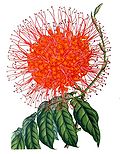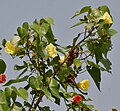Trees of India
| Order | Family | Species | Names | Image |
|---|---|---|---|---|
| Arecales | Arecaceae | Areca catechu | Supari in Hindi; सुपारी and Bengali; সুপারি (supārī) in Marathi; kamugu, paakku (fruit) in Tamil; kavugu, adike in Kannada; adakka-maram in Malayalam also; areca palm, areca nut palm, betel palm, betel nut palm, Indian nut, Pinang palm, catechu |  |
| Arecales | Arecaceae | Borassus flabellifer | Brab tree, toddy palm, tala palm; in Bengali (বাংলা) তাল; பனை மரம் in Tamil; ताड in Marathi; తాటి చెట్టు in Telugu; also doub palm, palmyra palm, tala or tal palm, toddy palm, lontar palm, wine palm, ice apple |  |
| Arecales | Arecaceae | Caryota urens | Toddy palm, kitul palm, jaggery palm, wine palm, sago palm, solitary fishtail palm |  |
| Arecales | Arecaceae | Cocos nucifera | नारिकेल in Sanskrit; नारळ in Marathi; नारियल in Hindi; नरीअर in Bhojpuri; தென்னை மரம் in Tamil; in Bengali (বাংলা) Narikel (নারিকেল); kobbari in Telugu; ತೆಂಗಿನ ಕಾಯಿ tengina kaayi in Kannada; also coconut |  |
| Arecales | Arecaceae | Phoenix sylvestris | Sendhi, salma, khaji, khajur in Hindi; खजूर khajūr in Marathi; khejur in Bengali খেজুর; kharjoora in Kannada; Itcham-pannai, paereecham in Tamil; also silver date palm, Indian date, sugar date palm, wild date palm |  |
| Arecales | Arecaceae | Phoenix canariensis | Canary date palm |  |
| Arecales | Arecaceae | Roystonea regia | Mountain glory, bottle Palm; also royal palm, Cuban royal palm, Florida royal palm |  |
| Boraginales | Boraginaceae | Cordia sebestena | siricote or kopté in 19th century northern Yucatán; scarlet cordia in Jamaica; Geiger tree |  |
| Brassicales | Caricaceae | Carica papaya | Papaya; Papita in Hindi; pepe or pe(n)pe in Bengali পেঁপে; पपई in Marathi; Parangi in Kannada; Pappali in Tamil; Boppai in Telugu; also papaw, pawpaw |  |
| Brassicales | Moringaceae | Moringa oleifera | Moringa/Drumstick tree; munga soudha in Hindi; সজনে in Bengali; sahajan in Bhojpuri; shevga-शेवगा in Marathi; nugge kayi in Kannada; midhosaragavo in Gujarati; mulaga in Telugu and murungai maram முருங்கை மரம் in Tamil; murungaikkai in Tamil and Malayalam; also horseradish tree |  |
| Brassicales | Salvadoraceae | Salvadora persica | Arak, galenia asiatica, peelu, pilu, Salvadora indica, Miswak मेसवाक; also toothbrush tree, jhak, mustard tree |  |
| Ericales | Lecythidaceae | Barringtonia asiatica | Mudilla, fish poison tree, putat, sea poison tree |  |
| Ericales | Lecythidaceae | Couroupita guianensis | कैलाशपति "तोफगोळ्याचे झाड in Marathi; नागलिंगम in Hindi, Tamil and Bengali; also cannon-ball tree |  |
| Ericales | Sapotaceae | Madhuca longifolia | Mohwa, mahula, banmahuva, maul (মহুল) in Bengali; madhuka in Sanskrit; mohwa, mahua, jangli-mona, maul in Hindi; मोह (moha) in Marathi; kat-illipi, illupai in Tamil; also madhūka, mahura, madkam, mahuwa, butter tree, mahura, mahwa, mohulo, iluppai, mee or ippa-chettu |  |
| Ericales | Sapotaceae | Mimusops elengi | (Bakul बकुळ; also Spanish cherry, medlar, bullet wood, বকুল in Bengali |  |
| Fabales | Fabaceae | Adenanthera pavonina | Rakta kambal in Bengali; thorligunj or ratangunj in Marathi ; guruvendi in Telugu; bandi in Tamil Anikundumani; also acacia coral, arbre À Église, bead tree, circassian seed, corail végétal, coral wood, madhoshi, moralitos, curly bean, deleite, delicia, dilmawi, graine-réglisse, jumbi-bead, l'Église, peronías, peonía, peonía extranjera, piriquiti, red bead tree, réglisse, Barbados pride, peacock flower fence, sandalwood tree, saga, manchadi |  |
| Fabales | Fabaceae | Butea monosperma | Kimshuka or Palasa in Sanskrit; Palash (পলাশ) in Bengali and Hindi; Porasum in Tamil; Parrot Tree; also flame of the forest, Bengal kino, dhak, palash, bastard teak |  |
| Fabales | Fabaceae | Cassia fistula | kanikkonna in Malayalam; kondrai in Tamil; also golden shower, purging cassia, Indian laburnum, kani konna, pudding-pipe tree |  |
| Fabales | Fabaceae | Cassia grandis | Pu vakai in Tamil; Konna in Malayalam; also pink shower tree, carao, horse cassia |  |
| Fagales | Casuarinaceae | Casuarina equisetifolia | विलायती सरू in Hindi; जंगली सरू in Marathi; சவுக்கு மரம் in Tamil; in Bengali (বাংলা) Jhau (ঝাউ); "sarugudu" in Telugu; GaaLi mara in Kannada; also coastal she-oak, horsetail she-oak, ironwood, beach she-oak, beach casuarina, whistling tree, Australian pine |  |
| Fabales | Fabaceae | Dalbergia sissoo | Sissoo, sisu, sheesham, tahli, Indian rosewood |  |
| Fabales | Fabaceae | Delonix regia | Mayaram மயரம் and neruppukkondrai maram in Tamil; shima sankesula in Telugu; কৃষ্ণচূড়া (krishnachura) in Bengali; and गुलमोहर (gulmohar) in Marathi and Hindi; also flame of the forest, flamboyant, royal peacock flower, royal gold mohur, fire tree |  |
| Fabales | Fabaceae | Erythrina variegata | Indian coral tree; mandara in Sanskrit, Hindi and Bengali; mandaram in Malayalam; kalyana murungai கல்யாண முருங்கை in Tamil; pangara-पांगारा in Marathi; also tiger's claw, Indian coral tree |  |
| Fabales | Fabaceae | Peltophorum pterocarpum | ताम्रशिंबी in Sanskrit and Marathi; lya vakai in Tamil; kon-dachinta in Telugu; also copperpod, yellow-flamboyant, yellow flametree, yellow poinciana, yellow-flame |  |
| Fabales | Fabaceae | Pithecellobium dulce | Manila tamarind, vilayati ambli in Gujarati; Jungle jalebi or ganga imli in Hindi; रानचिंच (rān chincha) in Marathi; seeme hunase in Kannada; సీమ చింతకాయ in Telugu; kodukkai puli maram in Tamil; also Madras thorn, monkeypod tree, camachile |  |
| Fabales | Fabaceae | Pongamia pinnata | Karanj or कारंजा in Hindi, Bengali, Marathi and Gujarati; pungam புங்கம் in Tamil; pungu in Telugu; also Indian beech, karanja, pongame oil tree |  |
| Fabales | Fabaceae | Pterocarpus santalinus | Red sanders, रक्तचंदन rakta chandana; also red saunders, yerra chandanam, chenchandanam, red sandalwood, rakta chandana, rakto chandon; রক্ত চন্দন in Bengali |  |
| Fabales | Fabaceae | Samanea saman | Saman or guango in Marathi; belaiti siris in Hindi; thoonguvaagai or thoongumoonji maram தூங்குவாகை in Tamil i.e. sleeping tree; also saman, rain tree, monkey pod |  |
| Fabales | Fabaceae | Saraca indica | Asoka tree, ashok, asoca, Sorrowless Tree (Often confused for Monoon longifolium , which is more common in India); অশোক (Ashok) in (বাংলা) Bengali ; |  |
| Fabales | Fabaceae | Senegalia catechu | Catechu, cachou, black cutch; also kher, cutchtree, black catechu |  |
| Fabales | Fabaceae | Tamarindus indica | Imli in Hindi; puli-புளி in Tamil; chinta in Telugu; তেঁতুল (tentul) in Bengali; chinch-चिंच in Marathi; amli in Gujarati; hunise hannu in Kannada; the Persian name Tamar-i-hind means Indian date |  |
| Fabales | Fabaceae | Vachellia nilotica | Gum arabic tree, babul, thorn mimosa, Egyptian acacia, thorny acacia |  |
| Gentianales | Apocynaceae | Plumeria rubra | Khera chapha or pandhra chapha-पांढरा चाफा in Marathi; champa or gulechin in Hindi; kath champa in Bengali; rhada champo in Gujarati; arali in Tamil; also frangipani, red paucipan, red-jasmine, red frangipani, common frangipani, temple tree, calachuchi, plumeria, champa, pagoda tree |  |
| Gentianales | Apocynaceae | Alstonia scholaris | Chhatim (ছাতিম) in Bengali; सप्तपर्णी in Marathi; also Blackboard tree, Indian devil tree, ditabark, milkwood pine, white cheesewood, Pulai, scholar tree |  |
| Lamiales | Bignoniaceae | Millingtonia hortensis | akas nim or nim chameli in Hindi; karkku கர்க்கு in Tamil; kavuku in Telugu; also Indian cork tree, jasmine tree |  |
| Lamiales | Bignoniaceae | Spathodea | Rudrapalash (রুদ্র পলাশ)in Bengali; पिचकारी Pichkari in Marathi and Hindi; patade in Telugu; patadi in Tamil; also bell flambeau, scarlet bell tree, fountain tree, syringe tree, squirt tree, African tulip tree and sometimes wrongly flame tree |  |
| Lamiales | Bignoniaceae | Jacaranda mimosifolia | Blue Jacaranda, palisander, nupur नुपुर; neelmohar नीलमोहर; green ebony tree, jacaranda, black poui, nupur, fern tree |  |
| Lamiales | Bignoniaceae | Tecomella Undulata | Desert teak, marwar teak, rohida |  |
| Lamiales | Lamiaceae | Gmelina arborea | Khamara in Hindi; kulimavu in Kannada; mara and shivani in Kashmiri; शिवान् in Marathi; also beechwood, gmelina, goomar teak, Kashmir tree, Malay beechwood, white teak, yamane, gamhar |  |
| Lamiales | Lamiaceae | Tectona grandis | Saigun in Hindi; saka in Sanskrit; sag-साग in Marathi; shegun (সেগুন) in Bengali; tega in Kannada; saga in Gujarati; also Indian Oak |  |
| Magnoliales | Annonaceae | Monoon longifolium | Ashoka or debdaru in Hindi; ashoka or devdaar in Marathi; asopala in Gujarati; nara in Telugu; devadaaru in Kannada; debdaru (দেবদারু) in Bengali; also mast tree, cemetery tree |  |
| Malpighiales | Calophyllaceae | Calophyllum inophyllum | Kath Champa, Sultana Champa, Punnaga in Sanskrit and Bengali; Sultana Champa, Surpan, Undi, Surpunka in Hindi; Pinnai and Punnagam in Tamil; also tamanu, oil-nut, mastwood, beach calophyllum, beautyleaf |  |
| Malpighiales | Clusiaceae | Garcinia indica | कोकम or आमसुल in Marathi and Kokani; bindin, biran, bhirand, bhinda, bhrinda, brinda, mangosteen, wild mangosteen, red mango; also kokum |  |
| Magnoliales | Magnoliaceae | Magnolia champaca | Champa (চম্পা) and champaka in Bengali and Hindi; चंपा or चाफा (champā or chāphā) in Marathi; chembuga and chambugam in Tamil; champaka in Telugu; champakam in Malayalam; sampige in Kannada; also joy perfume tree, yellow jade orchid tree, fragrant Himalayan champaca |  |
| Magnoliales | Myristicaceae | Myristica fragrans | Nutmeg |  |
| Malpighiales | Phyllanthaceae | Phyllanthus emblica | Amalaka in Sanskrit; amla in Hindi; आवळा (āwaLā) in Marathi; Amlaki in Bengali; Nellikkai in Kannada and Tamil; ఉసిరి in Telugualso; also emblic, emblic myrobalan, myrobalan, Indian gooseberry, Malacca tree |  |
| Malvales | Dipterocarpaceae | Shorea robusta | Sal tree, sāla, shala, sakhua, sarai |  |
| Malvales | Malvaceae | Adansonia digitata | Gorak amli and goram lichora in Hindi; Gorak chinch in Gujarati; Paparapulia & Perruka in Tamil; also monkey-bread tree, upside-down tree, cream of tartar tre |  |
| Malvales | Malvaceae | Thespesia populnea | पार्श्वपिप्पल (Pārśvapippala) in Sanskrit; पारोसा पिंपळ, आष्ट, पिंपरणी, पारस भेंडी in Marathi; பூவரசு in Tamil; గంగరావి in Telugu; also portia tree, Pacific rosewood, Indian tulip tree, milo, umbrella tree, portia |  |
| Malvales | Malvaceae | Sterculia | Jangli badam in Hindi and Bengali; gorapu-badam, gurapu-vadam, pottaikavalam in Tamil; also bastard poon tree, hazel sterculia, Indian almond |  |
| Malvales | Malvaceae | Bombax ceiba | काटे-सावरी Kāte sāvarī, savar or saur in Maharashtra; simal or shimbal in Hindi; hatti mara in Kannada; shimul in Bengali; ilavu or ilava maram இலவ மரம் in Tamil, Malayalam and Salmali; booruga in Telugu malabar; also silk-cotton tree, red silk-cotton, red cotton tree, or ambiguously as silk-cotton or kapok |  |
| Malvales | Malvaceae | Pterospermum acerifolium | Son chapha-सोनचाफा in Marathi; muchukunda in Bengali; kanak champa, kaniar, katha champa in Hindi; also bayur tree, karnikara tree |  |
| Myrtales | Combretaceae | Terminalia arjuna | Arjuna, arjun tree |  |
| Myrtales | Combretaceae | Terminalia catappa | जंगली बादाम Jaṅgalī bādāma in Hindi and Marathi, badam in Telugu; badami kaayi in Kannada |  |
| Myrtales | Combretaceae | Terminalia chebula | Black or chebulic myrobalan |  |
| Myrtales | Lythraceae | Lagerstroemia speciosa | Taman (तामण) or mota bondara in Marathi; arjuna in Hindi; jarul in Bengali; kaduli கடுலி in Tamil; vara gogu in Telugu; also giant crepe-myrtle, Queen's crepe-myrtle, banabá plant, pride of India |  |
| Myrtales | Myrtaceae | Syzygium cumini | Jamun in Hindi and Bhojpuri; kala jambu in Gujarati; kalojam in Bengali; ನೇರಳೆ NeraLe in Kannada; jambhul-जांभूळ in Marathi; naval or nagal in Tamil; also Malabar plum, Java plum, black plum, jamun, jaman, jambul, jambolan |  |
| Oxalidales | Oxalidaceae | Averrhoa bilimbi | balimbing, bimbli, belimbing, cucumber tree, tree sorrel |  |
| Rosales | Moraceae | Ficus elastica | Rubber fig, rubber bush, rubber tree, rubber plant, or Indian rubber bush, Indian rubber tree |  |
| Rosales | Moraceae | Ficus benghalensis | वटवृक्ष in Sanskrit; वड in Marathi; bargad in Hindi; aall and aala maram in Tamil; marri in Telugu; aalada mara ಆಲದ ಮರ in Kannada |  |
| Rosales | Moraceae | Ficus religiosa | Pipal in Hindi; asvattha in Bengali; ಅರಳಿ ಮರ araLi mara in Kannada; jari in Gujarati; pimpal-पिंपळ in Marathi; ashvatthame in Telugu; arasu or arasa maram அரச மரம் in Tamil; also bodhi tree, bo tree, peepul tree, peepal tree, pipala tree, ashvattha tree |  |
| Rosales | Moraceae | Artocarpus heterophyllus | Kanthal in Bengali; Kathal in Hindi; Pila and Palaa in Tamil; फणस (Phañas) in Marathi; Plaav, Plaavu or Chakka in Malayalam; Panasa in Sanskrit; halasu in Kannada and Telugu; jackfruit |  |
| Rosales | Rhamnaceae | Ziziphus mauritiana | बदरी (Badarī) in Sanskrit; बेर in Hindi and Bhojpuri; बोर in Marathi; kul in Bengali; இலந்தை in Tamil; also Indian jujube, Indian plum, Chinese date, Chinese apple, ber, dunks |  |
| Santalales | Santalaceae | Santalum album | Chandan in Hindi and Bengali; chandana in Sanskrit; चंदन-गंध or simply चंदन in Marathi; sri gandha in Kannada; also true sandalwood, white sandalwood, Indian sandalwood |  |
| Sapindales | Anacardiaceae | Mangifera indica | The tree is maa maram and the fruit is maangaai மாம்பழம் in Tamil; the fruit is keri in Gujarati; आंबा in Marathi; aam in Hindi and Bhojpuri; maamidi in Telugu; ಮಾವಿನ ಕಾಯಿMaavina kaayi in Kannada |  |
| Sapindales | Anacardiaceae | Semecarpus anacardium | Biba, ker in Kannada; also marking nut tree, Malacca bean tree, marany nut, oriental cashew, dhobi nut tree, varnish tree |  |
| Sapindales | Anacardiaceae | Anacardium occidentale | Mundhiri in Tamil; काजू in Marathi and Hindi; జీడి in Telugu; cashew |  |
| Sapindales | Meliaceae | Azadirachta indica | Vaembu or vaeppa maram வேப்ப மரம் in Tamil; कडुलिंब in Marathi; vepa in Telugu; ಬೇವಿನ ಮರ bevina mara in Kannada; also neem, margosa, nimtree, Indian lilac |  |
| Sapindales | Meliaceae | Melia azedarach | Chinaberry tree, pride of India, bead-tree, Cape lilac, syringa berrytree, Persian lilac, Indian lilac, white cedar |  |
| Sapindales | Rutaceae | Bergera koenigii | Karivaepilai கருவேப்பிலை in Tamil or Kadipatta; karivepa in Telugu; karibevu in Kannada; कडिपत्ता in Marathi; also curry tree |  |
| Sapindales | Rutaceae | Aegle marmelos | Bilva, bilwa, bel, kuvalam, koovalam, madtoum, beli fruit, Bengal quince, stone apple, wood apple, bael (or bili or bhel), golden apple, Japanese bitter orange |  |